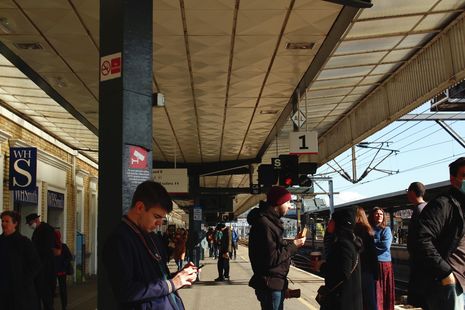Give it a Gove! Everything you need to know about Cambridge 2040
Marie-Madeleine Fuerbeth tracks the progress of the much-debated government project to make Cambridge into Europe’s Silicon Valley

In July 2023, a government plan concerning the massive expansion of Cambridge housing caught the attention of citizens and both local and national media. Nicknamed “Cambridge 2040”, the project involves investments in planning and constructing 250,000 lodgings in an entirely new-built quarter by the year 2040. The plan aims to tackle the current housing shortage in the region, thereby enabling further growth of the high-tech sector around Cambridge.
Cambridge 2040 is part of the “Long-term plan for housing” formulated by the Department for Levelling Up, Housing and Communities (DLUHC) in late July. The department follows the “levelling up” strategy, a concept introduced by Boris Johnson’s government in 2019 and currently led by Secretary of State Michael Gove. In a speech from 24 July 2023, Michael Gove outlined what Cambridge could look like in roughly 20 years. He stated that the department will create a vision for Cambridge that entails, in addition to more houses, the creation of a new green space ranking among the best parks globally and the significant expansion of laboratory space. While that may sound overly ambitious, some significant first steps towards Cambridge 2040 have already been taken. The Cambridge Delivery Group, chaired by Peter Freeman, head of England Homes, was created to serve as the central planning task force. £5m was allocated to the group.
“Some significant first steps towards Cambridge 2040 have already been taken”
However, this government scheme had not been called for by local organisations or authorities. The mayor of Cambridgeshire and Peterborough, Nik Johnson, even published a statement in early July explaining that local bodies had not received sufficient information about the megaproject. In fact, the DLUHC had not taken into account the city council’s urban development plans for the years 2022 to 2027. In the city council’s proposal, preserving biodiversity, developing a response to climate change, and tackling inequality through affordable housing are listed as main priorities. Building progress in four key areas, including the Cambridge Station area, the East Quadrant, North West Quadrant, and Southern Fringe, is trackable on the city council’s website. Conspicuously, the current annual growth rate of housing stock at 1.5% pales in comparison to the government’s projected increase for Cambridge’s population from 150,000 to 400,000 by 2040.
Given the controversy, what are the reasons for pushing Cambridge’s urban development to such an extent? Some believe that the “Cambridge Cluster” has the potential to contribute significantly to a revival of the British economy, which has been in decline for the past 50 years. The Cambridge Cluster is a network of Cambridge-based companies in the high technology sector, consisting of 26,218 businesses and yielding an annual turnover of £48bn in the 2021–2022 financial year, according to data from Cambridge Ahead, a business and academic member organisation. Cambridge has experienced significant growth since the establishment of the Science Park in the 1970s. Today, there is a shortage of available housing options for new professionals, resulting in a rise in real estate costs. Naturally, British politicians are committed to safeguarding the goal of having a cutting-edge technology centre, reminiscent of Silicon Valley, in the fens and claylands of the Cambridgeshire area.
“Cambridge on a Saturday is already quite difficult to navigate due to the sheer number of students and flaneurs”
Yet, many politicians and academics have publicly expressed concerns about the changes that would come with a new urban quarter in Cambridge. One cause for unease is the prospective densification of towns, which the DLUHC actually lists as one of its primary objectives. Cambridge on a Saturday is already quite difficult to navigate due to the sheer number of students and flaneurs. It is not uncommon to queue for 20 minutes to get your coffee. Although new shops and cafes are planned to be added to the new area, the historic city centre will likely remain the main attraction for incoming residents. Another problem is the limited water supply, for which the city and district are desperately trying to find a solution. The east of England is known to be the driest region in the UK with a constant threat of drought in the summer. Cambridge Water, the local water supply company, initiated the construction of a new reservoir that could make up for the current shortage. To protect the wildlife and guarantee sustainable growth, this project would have to be conducted with the utmost precaution and would only be finished by the mid-to-late 2030s – if everything goes according to plan. Until then, as the South Cambridgeshire District Council discussed in June, restrictions on water consumption may need to be implemented. Undoubtedly, a prompt and reliable solution to water supply challenges will be indispensable for the construction of future homes on a large scale.
In an effort to appease local officials, the DLUHC decided to include the Environment Agency, the Water Services Regulation Authority (otherwise known as Ofwat) and a water scarcity working group in Peter Freeman’s delivery group. An added sum of 3 million will help to enhance water efficiency in existing residences. Apart from that, a new governmental body called the Office for Place was put in charge of designing the new neighbourhood with the help of adjacent communities. With an appropriate look and feel, the modern Cambridge quarter will blend right in with the historic centre. That it could rival the picturesque buildings’ popularity is unlikely, but it might disperse the flocks of tourists a bit. In the end, it is paramount to recognise the current needs and problems of the city in the implementation of Cambridge 2040. The obstacles to a significant expansion of Cambridge are clear, which is why further information about the government scheme is eagerly anticipated.
 News / Clare Hall spent over £500k opposing busway 24 December 2025
News / Clare Hall spent over £500k opposing busway 24 December 2025 Comment / The ‘class’ of Cambridge24 December 2025
Comment / The ‘class’ of Cambridge24 December 2025 News / Caius mourns its tree-mendous loss23 December 2025
News / Caius mourns its tree-mendous loss23 December 2025 News / Girton JCR publishes open letter expressing solidarity with Palestine25 December 2025
News / Girton JCR publishes open letter expressing solidarity with Palestine25 December 2025 Comment / Yes, I’m brown – but I have more important things to say22 December 2025
Comment / Yes, I’m brown – but I have more important things to say22 December 2025










